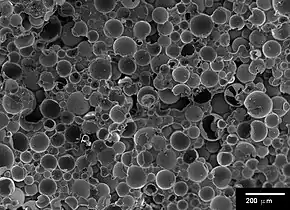Syntactic foam
Syntactic foams are composite materials synthesized by filling a metal, polymer,[1] cementitious or ceramic matrix with hollow spheres called microballoons[2] or cenospheres or non-hollow spheres (e.g. perlite) as aggregates.[3][4] In this context, "syntactic" means "put together."[5] The presence of hollow particles results in lower density, higher specific strength (strength divided by density), lower coefficient of thermal expansion, and, in some cases, radar or sonar transparency.

History
The term was originally coined by the Bakelite Company, in 1955, for their lightweight composites made of hollow phenolic microspheres bonded to a matrix of phenolic, epoxy, or polyester.[6][7]
These materials were developed in early 1960s as improved buoyancy materials for marine applications.[8] Other characteristics led these materials to aerospace and ground transportation vehicle applications.[9]
Research on syntactic foams has recently been advanced by Nikhil Gupta.
Characteristics
Tailorability is one of the biggest advantages of these materials.[10] The matrix material can be selected from almost any metal, polymer, or ceramic. Microballoons are available in a variety of sizes and materials, including glass microspheres, cenospheres, carbon, and polymers. The most widely used and studied foams are glass microspheres (in epoxy or polymers), and cenospheres or ceramics[11] (in aluminium). One can change the volume fraction of microballoons or use microballoons of different effective density, the latter depending on the average ratio between the inner and outer radii of the microballoons.
A manufacturing method for low density syntactic foams is based on the principle of buoyancy.[12][13]
Strength
The compressive properties of syntactic foams, in most cases, strongly depend on the properties of the filler particle material. In general, the compressive strength of the material is proportional to its density. Cementitious syntactic foams are reported to achieve compressive strength values greater than 30 MPa (4.4 ksi) while maintaining densities lower than 1.2 g/cm3 (0.69 oz/cu in).[14]
The matrix material has more influence on the tensile properties. Tensile strength may be highly improved by a chemical surface treatment of the particles, such as silanization, which allows the formation of strong bonds between glass particles and epoxy matrix. Addition of fibrous materials can also increase the tensile strength.
Applications

Current applications for syntactic foam include buoyancy modules for marine riser tensioners, remotely operated underwater vehicles (ROVs), autonomous underwater vehicles (AUVs), deep-sea exploration, boat hulls, and helicopter and airplane components.
Cementitious syntactic foams have also been investigated as a potential lightweight structural composite material. These materials include glass microspheres dispersed in a cement paste matrix to achieve a closed cell foam structure, instead of a metallic or a polymeric matrix. Cementitious syntactic foams have also been tested for their mechanical performance under high strain rate loading conditions to evaluate their energy dissipation capacity in crash cushions, blast walls, etc. Under these loading conditions, the glass microspheres of the cementitious syntactic foams did not show progressive crushing. Ultimately, unlike the polymeric and metallic syntactic foams, they did not emerge as suitable materials for energy dissipation applications.[15] Structural applications of syntactic foams include use as the intermediate layer (that is, the core) of sandwich panels.
Though the cementitious syntactic foams demonstrate superior specific strength values in comparison to most conventional cementitious materials, it is challenging to manufacture them. Generally, the hollow inclusions tend to buoy and segregate in the low shear strength and high-density fresh cement paste. Therefore, maintaining a uniform microstructure across the material must be achieved through a strict control of the composite rheology.[16] In addition, certain glass types of microspheres may lead to an alkali silica reaction. Therefore, the adverse effects of this reaction must be considered and addressed to ensure the long-term durability of these composites.[17]
Other applications include;
- Deep-sea buoyancy foams. A method of creating submarine hulls by 3D printing was developed in 2018.[18]
- Thermoforming plug assist
- Radar transparent materials
- Acoustically attenuating materials
- Cores for sandwich composites[19][20]
- Blast mitigating materials
- Sporting goods such as bowling balls, tennis rackets, and soccer balls.[21]
References
- Shutov, F.A. (1986). "Syntactic polymer foams". Advances in Polymer Science. 73–74: 63–123. doi:10.1007/3-540-15786-7_7. ISBN 978-3-540-15786-1.
- Kim, Ho Sung; Plubrai, Pakorn (September 2004). "Manufacturing and failure mechanisms of syntactic foam under compression". Composites Part A: Applied Science and Manufacturing. 35 (9): 1009–1015. doi:10.1016/j.compositesa.2004.03.013.
- Shastri, Dipendra; Kim, Ho Sung (16 June 2014). "A new consolidation process for expanded perlite particles". Construction and Building Materials. 60: 1–7. doi:10.1016/j.conbuildmat.2014.02.041. hdl:1959.13/1052767.
- "What is Syntactic Foam?". Cornerstone Research Group. Archived from the original on 20 July 2012. Retrieved 7 August 2009.
- "syntactic foam". Merriam-Webster.com Dictionary. Retrieved 22 June 2023.
- From the Oxford English Dictionary citation of Sci. News Let. 2 Apr. 213/3
- "Plastic Foam Developed for Boats and Planes". The Science News-Letter. 67 (14): 213. 2 April 1955. doi:10.2307/3935329. ISSN 0096-4018. JSTOR 3935329.
- Kudo, Kimiaki (January 2008). "Overseas Trends in the Development of Human Occupied Deep Submersibles and a Proposal for Japan's Way to Take" (PDF). Science and Technology Trends Quarterly Review. 26: 104–123. Archived from the original (PDF) on 21 July 2011. Retrieved 10 August 2009.
- Karst, G (2002). "Novel Processing of High-Performance Structural Syntactic Foams". Society for the Advancement of Material and Process Engineering. Archived from the original on 23 July 2011. Retrieved 7 August 2009.
- Bardella, L.; Genna F. (2001). "On the elastic behavior of syntactic foams". International Journal of Solids and Structures. 38 (2): 7235–7260. doi:10.1016/S0020-7683(00)00228-6.
- Shubmugasamy, V. (2014). "Compressive Characterization of Single Porous SiC Hollow Particles". JOM. 66 (6): 892–897. Bibcode:2014JOM....66f.892S. doi:10.1007/s11837-014-0954-7. S2CID 40553878.
- Islam, Md Mainul; Kim, Ho Sung (2007). "Manufacture of syntactic foams: pre-mold processing" (PDF). Materials and Manufacturing Processes. 22: 28–36. doi:10.1080/10426910601015857. S2CID 136610096.
- Islam, Md Mainul; Kim, Ho Sung (October 2008). "Manufacture of syntactic foams using starch as binder: post-mold processing" (PDF). Materials and Manufacturing Processes. 23 (8): 884–892. doi:10.1080/10426910802413661. S2CID 138333688.
- Gupta, Nikhil; Woldesenbet, Eyassu (September 2003). "Hygrothermal studies on syntactic foams and compressive strength determination". Composite Structures. 61 (4): 311–320. doi:10.1016/S0263-8223(03)00060-6.
- Bas, Halim Kerim; Jin, Weihua; Gupta, Nikhil; Luong, Dung D. (1 January 2019). "Strain rate-dependent compressive behavior and failure mechanism of cementitious syntactic foams". Cement and Concrete Composites. 95: 70–80. doi:10.1016/j.cemconcomp.2018.10.009. ISSN 0958-9465. S2CID 139598037.
- Bas, Halim Kerim; Jin, Weihua; Gupta, Nikhil; Behera, Rakesh Kumar (1 July 2018). "In-situ micro-CT characterization of mechanical properties and failure mechanism of cementitious syntactic foams". Cement and Concrete Composites. 90: 50–60. doi:10.1016/j.cemconcomp.2018.03.007. ISSN 0958-9465. S2CID 140068274.
- Bas, Halim Kerim; Jin, Weihua; Gupta, Nikhil (1 April 2021). "Chemical stability of hollow glass microspheres in cementitious syntactic foams". Cement and Concrete Composites. 118: 103928. doi:10.1016/j.cemconcomp.2020.103928. ISSN 0958-9465. S2CID 234059434.
- "3-D Printing Breakthrough for Lightweight Syntactic Foams Could Help Submarines Dive Deeper | NYU Tandon School of Engineering". engineering.nyu.edu. Retrieved 22 September 2018.
- Islam, Md Mainul; Kim, Ho Sung (2012). "Sandwich composites made of syntactic foam core and paper skin: manufacturing and mechanical behavior". Journal of Sandwich Structures and Materials. 14 (1): 111–127. doi:10.1177/1099636211413564. S2CID 135970284.
- Arifuzzaman, Md; Kim, Ho Sung (1 September 2017). "Novel flexural behaviour of sandwich structures made of perlite foam/sodium silicate core and paper skin". Construction and Building Materials. 148: 321–333. doi:10.1016/j.conbuildmat.2017.05.073.
- Thim, Johann (3 February 2005). "Performing Plastics - How plastics set out to conquer the world of sports". European Chemical Industry Council. Retrieved 10 August 2009.
External links
 Media related to Syntactic foam at Wikimedia Commons
Media related to Syntactic foam at Wikimedia Commons